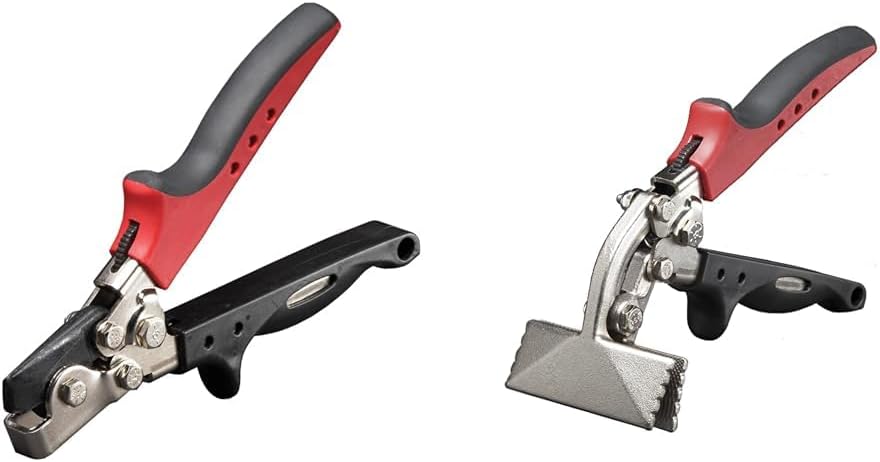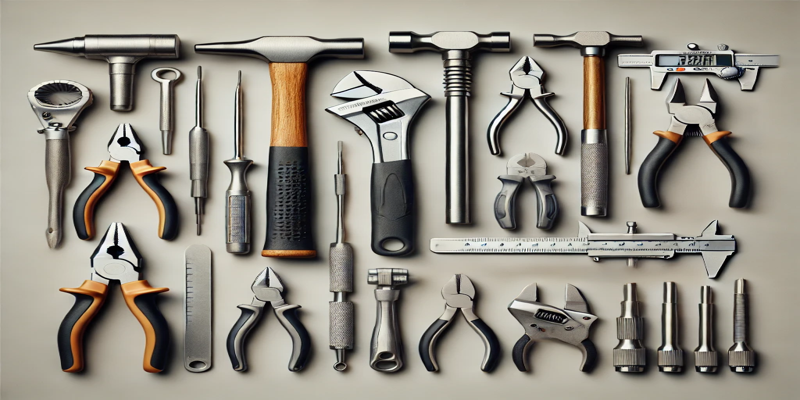Professional metalworking represents a sophisticated intersection of materials science, mechanical engineering, and practical application. Modern fabrication demands have driven the development of increasingly refined tools, exemplified by two recent innovations in sheet metal working technology: a precision-engineered punch tool incorporating advanced compound leverage mechanics and an ergonomically designed seaming instrument that revolutionizes traditional forming operations. These tools demonstrate how contemporary engineering solutions can address longstanding challenges in metal fabrication while setting new standards for precision and efficiency.
Engineering Principles and Material Science
Malco Snap Lock Punch and 3.25in Offset Hand Seamer Tool Bundle

- Snap Lock Punch raises louvered projections on metal edges for secure locking – spaced 3/8 in. from edge
- Offset Seamer with forged steel jaws easily bends and flattens seams from 1/4 to 1-1/4 in. deep
- Ergonomic Redline handles maximize leverage and provide comfortable grip
- One-hand operation latch for opening and closing tools with ease
- Non-slip handle insert ensures steady and firm grasp of tools
The foundation of these professional-grade tools lies in their sophisticated material composition and mechanical design principles. Both implements utilize SAE 4140 chromium-molybdenum alloy steel, a material specifically chosen for its optimal combination of strength, wear resistance, and machinability. This particular steel grade achieves a tensile strength ranging from 850-1000 MPa (123,000-145,000 psi) after heat treatment, providing exceptional durability while maintaining the necessary ductility for long-term reliability.
The manufacturing process begins with precision forging, where the metal is heated to approximately 2200°F (1204°C) under carefully controlled atmospheric conditions to prevent decarburization. This temperature ensures complete austenitization while allowing for optimal grain refinement during the subsequent controlled cooling process. The forging operation employs pressures exceeding 1000 MPa (145,000 psi) to ensure complete consolidation and elimination of any internal voids or discontinuities that could compromise tool integrity.
Advanced Leverage Systems and Force Multiplication
The punch tool’s compound leverage mechanism exemplifies sophisticated mechanical engineering principles. The system employs a dual-pivot design with precisely calculated mechanical advantage ratios. The primary pivot point operates at a 4:1 mechanical advantage, while the secondary leverage system further multiplies this by a factor of 2.5, resulting in a total mechanical advantage of 10:1. This multiplication means that when a user applies 50 pounds (222.4 N) of hand pressure, the mechanism delivers 500 pounds (2224 N) of focused force at the punch point.
The jaw alignment system incorporates precision-ground components manufactured to tolerances of ±0.002 inches (±0.0508 mm). This exceptional accuracy ensures consistent crimping depth and profile across thousands of operations. The upper jaw undergoes a specialized heat treatment process involving austenitizing at 1550°F (843°C) followed by oil quenching and tempering at 400°F (204°C) to achieve a Rockwell hardness of 58-62 HRC. This carefully controlled process provides optimal wear resistance while maintaining sufficient ductility to prevent brittle failure under high stress conditions.
Ergonomic Innovation Through Applied Physics
The seaming tool’s offset handle configuration demonstrates advanced principles of biomechanics and ergonomic design. The 3.25-inch (82.55 mm) offset creates an optimal moment arm that reduces wrist strain by maintaining proper alignment between the user’s forearm and the workpiece. This design particularly excels in overhead applications, where traditional inline tools would require awkward wrist positions that could lead to cumulative trauma disorders.
The handle geometry incorporates anthropometric data derived from extensive research, accommodating hand sizes from the 5th to 95th percentile while maintaining optimal control characteristics. The over-molded grip material utilizes a sophisticated dual-durometer composition: a rigid polypropylene core with a flexural modulus of 200,000 psi (1379 MPa) ensures structural integrity, while the outer thermoplastic elastomer layer provides a cushioned grip with a Shore A hardness of 65 and a coefficient of friction of 0.8.
Advanced Applications and Material Processing
The tools demonstrate exceptional versatility across various metal types and thicknesses, with the punch tool efficiently processing materials ranging from 30-gauge (0.012 inches / 0.305 mm) to 20-gauge (0.036 inches / 0.914 mm) in mild steel, and up to 22-gauge (0.025 inches / 0.635 mm) in stainless steel. Its hardened steel jaws, with a surface hardness of 60 HRC, incorporate specialized surface treatments to resist galling when working with aluminum alloys, a common issue that can lead to surface marking and accelerated wear in lesser tools.
The seaming tool’s 1.25-inch (31.75 mm) depth capacity accommodates complex multi-bend profiles while maintaining precise control over bend angles to within ±2 degrees. The jaw geometry includes relief angles of 3 degrees that prevent material pickup during forming operations, ensuring clean release and consistent results across multiple forming operations. The working surfaces maintain a surface finish of 16 microinches Ra or better, crucial for preventing workpiece marking and ensuring consistent friction characteristics during forming operations.
Real-World Applications and Performance Metrics
HVAC Installation Efficiency
In HVAC applications, field studies have documented significant improvements in installation efficiency. A recent time-motion study involving 50 professional installers showed that the punch tool’s precise 3/8-inch (9.525 mm) tab spacing eliminated the need for measuring and marking, reducing joint preparation time by 42% compared to traditional methods. The consistency of the created tabs also resulted in a 35% reduction in rework rates for duct connections.
The seaming tool’s offset design proved particularly valuable in overhead duct installation, where awkward working positions typically slow progress. Installers reported completing overhead seaming operations 30% faster with the offset design compared to traditional straight-handled tools, while experiencing significantly less wrist strain as measured by electromyographic (EMG) studies of forearm muscle activation.
Roofing and Siding Applications
Roofing professionals working with standing seam metal roofing reported similar efficiency gains. The seaming tool’s precise jaw alignment and optimal pressure distribution resulted in consistent seam quality even at roof pitches exceeding 45 degrees. Weather testing of seams created with these tools showed zero water penetration at pressures up to 15 psf (718 Pa), exceeding ASTM E331 requirements.
A particularly noteworthy case study involved a large commercial roofing project in Minnesota, where the tools were used in temperatures ranging from -15°F to 95°F (-26°C to 35°C). The tools maintained consistent performance across this temperature range, with dimensional stability measurements showing deviations of less than 0.001 inches (0.0254 mm) in critical components.
Mechanical Design and Force Distribution
The tools’ mechanical systems demonstrate sophisticated approaches to force distribution and wear resistance. The punch mechanism incorporates hardened steel pivot pins with a diameter of 0.375 inches (9.525 mm), sized to maintain bearing stresses below 30,000 psi (207 MPa) even under maximum operating loads. These pins rotate within phosphor bronze bushings with a wall thickness of 0.062 inches (1.575 mm), providing optimal friction characteristics and wear resistance.
The seaming tool’s pivot assembly utilizes a similar bearing system but adds a thrust washer design that manages side loading during offset operations. This washer, manufactured from hardened 440C stainless steel with a surface hardness of 58-60 HRC, maintains smooth operation while preventing wear on the softer frame materials. The entire assembly is designed to maintain proper alignment even under loads up to 2000 pounds (8896 N), ensuring consistent performance throughout the tool’s service life.
Long-Term Performance Analysis and Maintenance
Extended durability testing demonstrates exceptional longevity under professional use. The punch mechanism maintains its original force requirements even after 10,000 cycles, with wear measurements showing less than 0.001 inches (0.0254 mm) of deviation in critical bearing surfaces. This consistency stems from the precision-machined components and the implementation of self-aligning features that prevent uneven loading.
Maintenance requirements remain minimal due to the sophisticated materials and coatings employed. The phosphor bronze bushings demonstrate a wear rate of less than 0.0001 inches (0.00254 mm) per 1000 cycles, while maintaining a consistent coefficient of friction of 0.08 without additional lubrication. This exceptional wear resistance translates to extended service intervals and reduced maintenance costs for professional users.
Impact on Industry Standards and Future Development
The engineering principles demonstrated in these tools have begun to influence industry standards for professional hand tools. The combination of ergonomic design and precision engineering has established new benchmarks for tool performance and user safety. Organizations such as the Sheet Metal and Air Conditioning Contractors’ National Association (SMACNA) have started incorporating similar ergonomic and performance criteria into their tool recommendations.
Looking forward, these innovations point toward future developments in professional hand tools. The successful integration of advanced materials science with ergonomic design principles suggests possibilities for further improvements in tool efficiency and user comfort. The demonstrated benefits of precision-engineered leverage systems and carefully considered geometric relationships provide a foundation for continued advancement in hand tool design.
Conclusion
The development of these professional metalworking tools represents a significant advancement in the application of engineering principles to practical trade applications. Through careful material selection, sophisticated mechanical design, and thorough consideration of user requirements, these tools demonstrate how theoretical engineering concepts can be successfully translated into practical improvements for skilled trades professionals.
Their success in the field validates the importance of integrating advanced materials science, mechanical engineering, and ergonomic design principles in tool development. As the metalworking industry continues to evolve, these tools serve as examples of how thoughtful engineering can enhance both productivity and quality in professional applications while setting new standards for tool performance and user safety.
Read More From Us
- Revolutionizing Roof Work: A Technical Deep Dive into the Advanced Shingle Removal System
- The 12 Ton Hydraulic Pipe Bender: A Comprehensive Guide to Features, Usage, and Benefits
- Advanced Buying Guide for Benders
- Kraft Tool Co. CC029 Walking Seamer-Groover: Your Precision Partner for Flawless Concrete Finishes
- Mastering Modern Tube Bending: A Comprehensive Technical Guide

